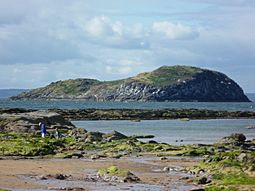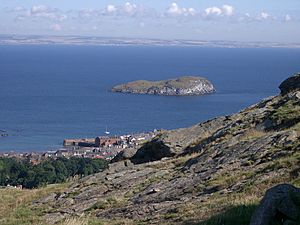Craigleith facts for kids
| Gaelic name | Creag Lìte |
|---|---|
| Meaning of name | rock of Leith |
 Craigleith from the East Bay, North Berwick |
|
| Coordinates | 56°04′24″N 2°43′08″W / 56.073363°N 2.718848°W |
| Physical geography | |
| Island group | Islands of the Forth |
| Highest elevation | 45 metres (148 ft) |
| Administration | |
| Sovereign state | United Kingdom |
| Country | Scotland |
| Council area | East Lothian |
| Demographics | |
| Population | 0 |
Craigleith is a small island located in the Firth of Forth, a large bay in Scotland. It's found near the town of North Berwick in East Lothian. The island's name, Creag Lìte, comes from the Scottish Gaelic language, meaning "rock of Leith." At its highest point, Craigleith stands about 45 meters (148 feet) tall.
Contents
What is Craigleith Island?
Craigleith is one of four islands found near North Berwick. The other islands are Bass Rock, Fidra, and the Lamb. Craigleith is the closest of these islands to North Berwick's harbour. Like its neighbors, Craigleith is a popular home for many different kinds of birds. People who enjoy diving often explore the waters around the island.
How was Craigleith formed?
Craigleith was formed by ancient volcanic activity. It is a type of lava dome called a laccolith. This means that hot, molten rock pushed up the layers of rock above it, but didn't break through to the surface. The area around Lothian in Scotland has many signs of old volcanoes, like the famous Bass Rock and Arthur's Seat. Craigleith is made of a special rock called essexite. This rock is often used to make curling stones, which are used in the sport of curling.
Wildlife on Craigleith
Craigleith has a rich history of wildlife. For a long time, it was known as a "rabbit warren." This means that rabbits were raised there on purpose for food.
What happened to the rabbits?
Sadly, in the 1950s, a disease called myxomatosis wiped out the rabbits on the island. Myxomatosis is a serious and often deadly disease that affects rabbits. However, in 2008, rabbits mysteriously appeared on the island again, and some have been seen recently.
Puffins and the SOS Puffin Project
Craigleith was once home to one of the biggest puffin colonies in Britain. There were about 28,000 pairs of these colorful birds living there. But starting in 1999, the puffin population faced a big problem. A plant called tree mallow started to grow out of control. This plant thrived because winters were getting warmer. The tree mallow grew so thick that it blocked the puffins' burrows, which are their underground nests. This made it very hard for the puffins to raise their baby chicks, called "pufflings."
To help the puffins, a project called SOS Puffin was started in 2007. It was led by the Scottish Seabird Centre in North Berwick. Hundreds of volunteers have worked hard to remove the tree mallow from the island. They travel by boat from the Seabird Centre during the winter months, when the puffins are out at sea. Early results show that the puffins are starting to come back to the island to breed again!
Other birds on the island
Besides puffins, other seabirds also breed on Craigleith. These include cormorants, shags, and guillemots.
Visiting Craigleith
The Scottish Seabird Centre has special solar-powered cameras on the islands. These cameras send live pictures of the puffins and other wildlife. You can watch them on their live webcams. Since 2008, daily boat trips have been offered around the island, allowing people to see the amazing wildlife up close.


